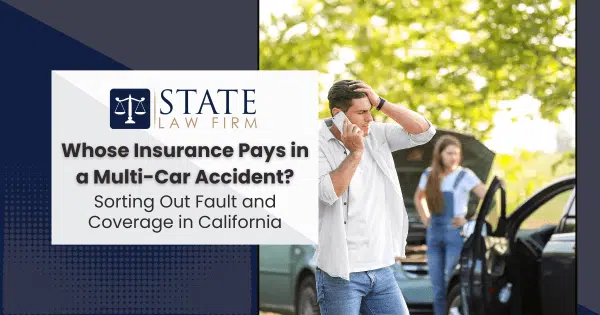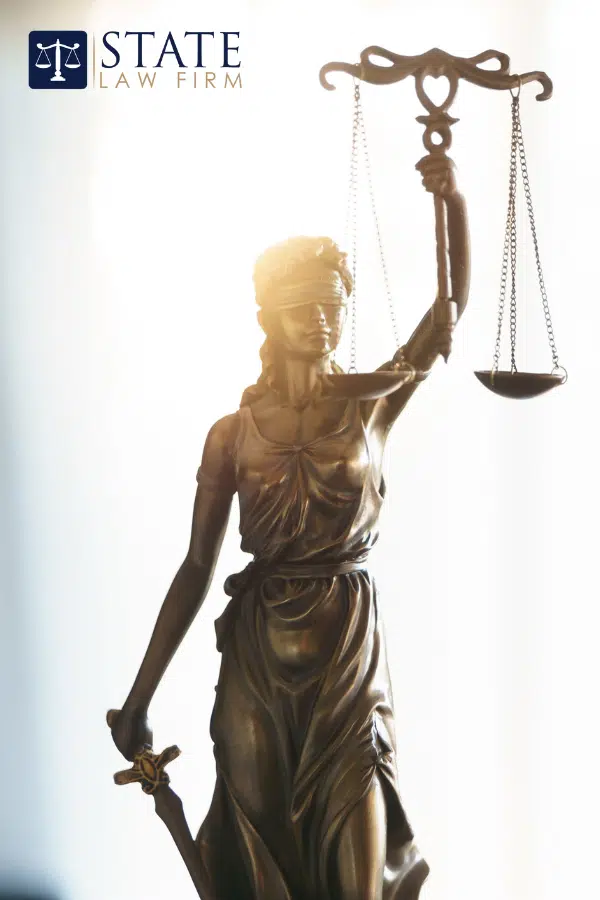Multi-car accidents are some of the most complicated collisions on California roads. They often involve several drivers, multiple insurance companies, and questions about how fault should be divided. For anyone involved, the process of sorting out coverage can quickly become confusing.
At State Law Firm, we’ve seen firsthand how overwhelming these cases can be. Our team of young attorneys is building a reputation for tackling complex claims and helping clients secure fair outcomes. We believe that clear guidance makes a real difference when you’re facing an uncertain recovery.
The numbers underscore how serious these accidents can be. In California, 44% of all fatal crashes involve multiple vehicles, according to the Insurance Institute for Highway Safety IIHS. That means nearly half of the most severe accidents in the state raise the very questions this article addresses: Who is responsible, and whose insurance will pay?
In the sections that follow, we’ll break down how fault is determined, how insurance companies handle multi-car claims, and what coverage options might come into play. If you’re looking for personal support, you can learn how our San Buenaventura car accident attorneys support victims of vehicle crashes or reach out directly for a free consultation.
Understanding Multi-Car Accidents: What You Need to Know
Multi-car accidents happen more often than people realize. They typically involve three or more vehicles and are common on California’s crowded freeways and intersections. These crashes are sometimes called “pile-ups” and can create a chain reaction that makes it difficult to see who started it.
According to the Insurance Institute for Highway Safety, 44% of fatal crashes in California involve multiple vehicles. With numbers this high, it’s clear that every driver needs to understand how these cases are handled.
Key factors that often contribute to multi-car accidents include:
- Distracted or impaired driving
- Speeding or following too closely
- Sudden stops in heavy traffic
- Hazardous weather or poor visibility
Pro Tip: If you’re ever involved in one of these accidents, never admit fault at the scene. Liability in multi-car collisions is rarely clear-cut and usually requires investigation.
Determining Fault in a Multi-Car Accident: California’s Comparative Negligence Law
California follows a comparative negligence system. This means fault can be shared among multiple drivers, and each person’s responsibility is assigned as a percentage.
For example, if Driver A is found 60% at fault and Driver B is 40% at fault, each driver’s insurance pays according to that split. Even if you’re partially responsible, you may still recover damages—your award is simply reduced by your share of fault.
What makes these cases more complex is that:
- Police reports may not fully capture the chain reaction of events.
- Witness statements can conflict.
- Insurance companies often dispute percentages of liability.
Pro Tip: The earlier you contact an attorney, the more effectively evidence like skid marks, traffic camera footage, and witness accounts can be preserved to build your case.
The Role of Insurance Companies in Multi-Car Accident Claims
Insurance companies step in quickly after a multi-car accident—but their goals don’t always align with yours. Adjusters are trained to minimize payouts, and in multi-party accidents, disputes often drag on longer than single-car claims.
Here’s how insurers usually handle these cases:
- Investigating liability through police reports, photos, and statements
- Allocating percentages of fault between drivers
- Communicating with other insurers involved in the collision
- Negotiating settlements or taking the claim to mediation
Different coverages may come into play, such as:
- Liability insurance (pays for damage you cause to others)
- Uninsured/underinsured motorist coverage (covers you if another driver doesn’t have enough insurance)
- Medical payments coverage (covers medical costs regardless of fault)
Pro Tip: Be cautious when giving recorded statements to insurance companies. Even an innocent comment can be used to reduce your claim.
Navigating Coverage Options: What to Expect from Your Insurance Policy
Many drivers don’t fully understand what their policies cover until after an accident. In a multi-car collision, knowing the difference between types of coverage is essential.
- Liability Coverage: Pays for injuries or property damage you cause to others.
- Collision Coverage: Pays for repairs to your own car, regardless of fault.
- Comprehensive Coverage: Covers non-collision damage like theft or natural disasters.
- Uninsured/Underinsured Motorist Coverage: Protects you if another driver doesn’t carry enough insurance.
Pro Tip: Review your policy at least once a year. Multi-car accidents often reveal gaps in coverage that could leave you paying out of pocket.
If you’re unsure what your current policy covers, reaching out to a lawyer can help you understand how your coverage would actually apply in real-world situations.
What to Do After a Multi-Car Accident: Steps to Take Immediately
The moments after a crash are often chaotic, but your actions can make a significant difference in protecting your health and your claim.
Here’s what to do right away:
- Check for injuries and call 911 if anyone is hurt.
- Move to safety if vehicles are blocking traffic and it’s safe to do so.
- Document the scene with photos and videos of all cars, skid marks, and road conditions.
- Exchange information with every driver involved, including insurance details.
- Gather witness contact information in case their statements are needed later.
- Notify your insurer but avoid admitting fault or speculating about what happened.
Pro Tip: The sooner you seek medical care, the stronger your case will be. Insurance companies often argue that delays in treatment mean your injuries aren’t related to the accident.
Understanding Your Rights and Responsibilities After a Multi-Car Accident in California
Multi-car accidents bring unique challenges, from shared fault to complex insurance disputes. Knowing your rights under California’s comparative negligence law and understanding your insurance coverage can help you navigate the process more confidently.
At State Law Firm, we’ve built our practice around helping clients cut through the confusion and secure fair compensation. If you’ve been involved in a crash, learn how our San Buenaventura car accident attorneys support victims of vehicle crashes. You can also schedule a free consultation to understand your options and next steps better.


